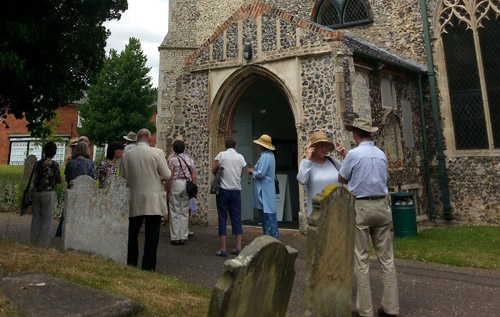The Norfolk Historic Buildings Group (NHBG) held its Annual General Meeting in St Michael’s, Reepham, on 11 July.

NHBG studies the history of Norfolk’s buildings. Projects include the buildings of Tacolneston and New Buckenham in South Norfolk, Norfolk’s rural schools, and most recently the buildings at the Pilgrimage Centre of Little Walsingham.
In addition, NHBG uses its expertise to undertake surveys for owners who would like to know more about their houses. Several houses in Reepham have been surveyed, including the Cardinal’s Hat and York House, near the churchyard.
The AGM was preceded by a walk to explore Reepham’s built history. This started at the churchyard, site of the churches for the three parishes which met here. One church was damaged in the great fire of 1543 and its tower demolished in 1796.
Reepham did not have a separate entry in Domesday Book – it is listed as part of Kerdiston, which like Whitwell and Hackford were more important places in 1068.
Kerdiston was the residence of the de Kerdiston family, whose impressive monuments can be seen in St Marys, Reepham. The de Kerdistons eventually moved their main residence to Claxton, and Reepham became the centre of the area and the name used for all three parishes.
After 1277 the market shifted from its probable earlier position in the churchyard. A plan of the Market Place of about 1600 shows a small building in the centre that may be the market cross, similar to that which still exists at Wymondham.
The Market Place was probably much larger as over the years stalls became permanent buildings and encroached onto the original area. Many of the frontages around the market square are Georgian; in a few cases a “modern” frontage on a much older property.
The Group stopped to look at Reepham’s first two schools, one on Norwich Road built by the rector in 1847 (now a private house) and the other built in 1860 in the churchyard (now Reepham Town Hall). These were replaced by the current (much changed) primary school in 1894.
Anne Woollett
- If you would like to find out more about NHBG or would like them to help you discover more about your house, visit www.nhbg.org.uk or contact Lynne Hodge lynne@walknorfolk.co.uk
